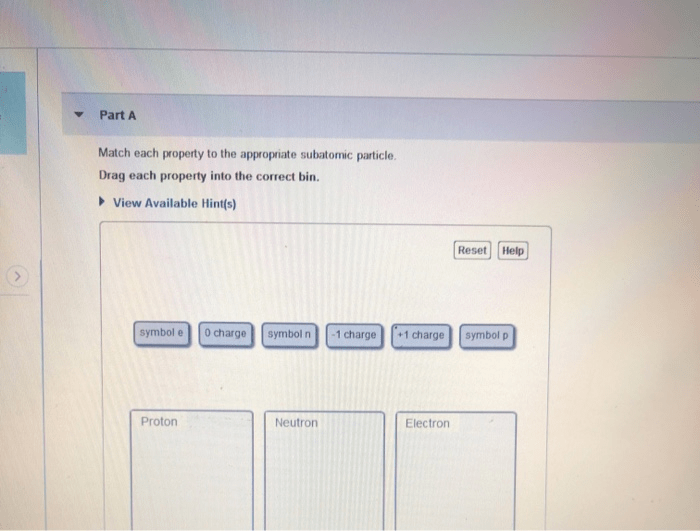Drag each subatomic particles into the correct bin – Embark on a scientific odyssey with “Drag Each Subatomic Particle into the Correct Bin.” This comprehensive guide unveils the fascinating world of subatomic particles, delving into their properties, classifications, and interactions. Prepare to unravel the secrets of the fundamental building blocks of matter and discover the forces that govern their behavior.
Our journey begins with an exploration of the fundamental criteria used to classify subatomic particles into distinct categories: leptons, quarks, bosons, and other exotic particles. We will delve into the unique characteristics of each group, examining their charges, masses, and other defining properties.
Subatomic Particle Classification

Subatomic particles are the fundamental building blocks of matter. They are classified into four main categories: leptons, quarks, bosons, and other. The criteria for classification include charge, mass, spin, and interactions.
Leptons, Drag each subatomic particles into the correct bin
Leptons are subatomic particles with half-integer spin and no color charge. They are further classified into three generations:
- First generation: electron, electron neutrino
- Second generation: muon, muon neutrino
- Third generation: tau, tau neutrino
Quarks
Quarks are subatomic particles with fractional charge and color charge. They are the building blocks of hadrons, such as protons and neutrons. There are six types of quarks:
- Up quark (u)
- Down quark (d)
- Charm quark (c)
- Strange quark (s)
- Top quark (t)
- Bottom quark (b)
Quarks interact through the strong nuclear force, which is mediated by gluons.
Bosons
Bosons are subatomic particles with integer spin. They are responsible for mediating the fundamental forces of nature. The four fundamental forces and their associated bosons are:
- Electromagnetic force: photon
- Weak nuclear force: W and Z bosons
- Strong nuclear force: gluons
- Gravitational force: graviton (hypothetical)
FAQ Insights: Drag Each Subatomic Particles Into The Correct Bin
What is the significance of classifying subatomic particles?
Classifying subatomic particles allows us to understand their behavior, interactions, and the forces that govern them. It provides a framework for organizing and comprehending the vast array of particles that make up the universe.
How do scientists determine the properties of subatomic particles?
Scientists use a variety of experimental techniques, such as particle accelerators and detectors, to study the properties of subatomic particles. These experiments allow researchers to measure the particles’ charges, masses, spins, and other characteristics.
What are some examples of subatomic particles that do not fit into the categories of leptons, quarks, or bosons?
Examples of subatomic particles that do not fit into the categories of leptons, quarks, or bosons include neutrinos, which are massless particles that interact only weakly with other matter, and Higgs bosons, which are responsible for giving mass to other particles.



